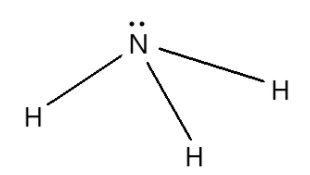
Statement I: Ammonia has a trigonal pyramidal molecular geometry.
Statement II: Ammonia has a tetrahedral electron pair geometry with the three atoms bonded to the central atom.
A. True, true, correct explanation
B. True, true, not correct explanation
C. True, false
D. False, true
Answer
488.1k+ views
Hint: Ammonia is a compound with one nitrogen atom as centre and three hydrogen atoms connected to it. It has three bond pairs of electrons and one lone pair of electrons.
Complete step by step answer:
Before answering this question we need to know everything about ammonia.
Ammonia is a compound of nitrogen and hydrogen with the formula
The structure of ammonia is as given below,

The ammonia molecule has a trigonal pyramidal shape as predicted by the valence shell electron pair repulsion theory with a bond angle of
Now, according to the question both the statements are correct as it has trigonal geometry and a tetrahedral electron pair with three atoms bonded to the central atom.
Therefore, option A is correct.
Note:
Ammonia has four electron pairs and its geometry is based on tetrahedral arrangement of electron pairs. It has three bonded groups and one lone pair. The shape of ammonia is trigonal pyramidal.
Complete step by step answer:
Before answering this question we need to know everything about ammonia.
Ammonia is a compound of nitrogen and hydrogen with the formula
The structure of ammonia is as given below,

The ammonia molecule has a trigonal pyramidal shape as predicted by the valence shell electron pair repulsion theory with a bond angle of
Now, according to the question both the statements are correct as it has trigonal geometry and a tetrahedral electron pair with three atoms bonded to the central atom.
Therefore, option A is correct.
Note:
Ammonia has four electron pairs and its geometry is based on tetrahedral arrangement of electron pairs. It has three bonded groups and one lone pair. The shape of ammonia is trigonal pyramidal.
Latest Vedantu courses for you
Grade 10 | CBSE | SCHOOL | English
Vedantu 10 CBSE Pro Course - (2025-26)
School Full course for CBSE students
₹37,300 per year
EMI starts from ₹3,108.34 per month
Recently Updated Pages
Master Class 11 Economics: Engaging Questions & Answers for Success

Master Class 11 Business Studies: Engaging Questions & Answers for Success

Master Class 11 Accountancy: Engaging Questions & Answers for Success

Master Class 11 English: Engaging Questions & Answers for Success

Master Class 11 Computer Science: Engaging Questions & Answers for Success

Master Class 11 Maths: Engaging Questions & Answers for Success

Trending doubts
State and prove Bernoullis theorem class 11 physics CBSE

1 ton equals to A 100 kg B 1000 kg C 10 kg D 10000 class 11 physics CBSE

State the laws of reflection of light

One Metric ton is equal to kg A 10000 B 1000 C 100 class 11 physics CBSE

Difference Between Prokaryotic Cells and Eukaryotic Cells

1 Quintal is equal to a 110 kg b 10 kg c 100kg d 1000 class 11 physics CBSE




